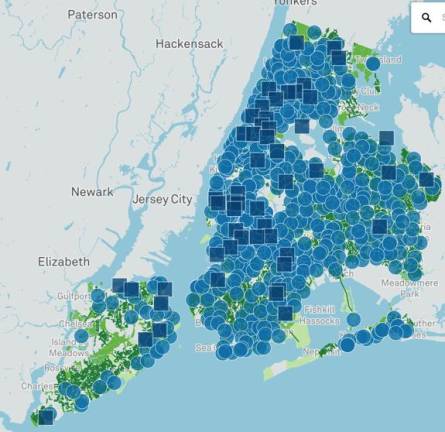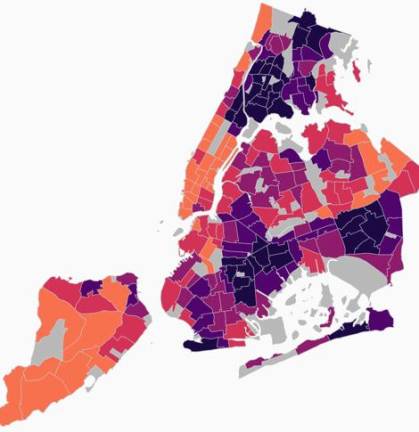How New Yorkers Can Survive this Summer by Staying Cool
Out of 370 deaths on average every year over the summer due to heat, 100 of those are due to excessive heat. The others occur on hot but not extremely hot days Cari Olson, the assistant commissioner of the Bureau of Environmental Surveillance and Policy with the NYC Department of Health and Mental Hygiene says. Olson brings attention to the life-threatening risks of the rising temperatures this summer and tips on how New Yorkers can stay cool this summer. The city is also taking initiative to help New Yorkers stay cool with their public Cooling Centers and NYC Parks nearest bodies of water for a dive or splash.
We survived an orange sky, and now we are looking at a high 80 degree to low 90-degree weather forecast for the next two weeks. The Emergency Management and Department of Health and Mental Hygiene has our backs to stay cool this summer and survive—quite literally.
“Out of 370 deaths on average every year over the summer due to heat, 100 of those are due to excessive heat. The others occur on hot but not extremely hot days,” Cari Olson, the assistant commissioner of the Bureau of Environmental Surveillance and Policy with the NYC Department of Health and Mental Hygiene said in the Emergency Management Podcast “Prep Talk.”
Some people do not recognize the detriment of heat in comparison to natural disasters or calamities—but Olson says they should. “Heat actually kills more people every year, in our city, in our state and our country than all other kinds of extreme weather combined,” Olson said in the podcast. “We not only need to be focusing on heat emergencies—we need to be thinking about how we can make ourselves and our city more resilient through structural and policy changes.”
A large proponent to excessive heat is climate change, Dr. Ashwin Vasan, health commissioner states. “Climate change is already making our summers hotter and more deadly. Heat-related deaths are preventable. We can protect New Yorkers by making sure all who need it have access to air conditioning, which provides the best protection for those at risk.”
The population of people most likely to face the greatest risk from excessive heat are those over 65 years old, and those with chronic health conditions including heart, kidney and lung disease, mental health conditions, substance, or alcohol abuse as well as those who don’t have access to air conditioning.
Those without air conditioning can call 311 or check online to see if they qualify for a free air conditioner through the New York State Home Energy Assistance Program (HEAP). To qualify for the cooling assistance program, households must meet certain income requirements, receive public benefits, have received a HEAP benefit during the current HEAP year, or have a household member with a medical condition that is exacerbated by the heat.
As of 2020, New York State extended eligibility to include people living in public housing or who receive housing benefits or subsidies and who also meet certain health qualifications. The program opened May 1 and the applications will be accepted through August 31, 2023, or until funds are exhausted.
“We encourage New Yorkers to take advantage of all the free resources available from the city to beat the heat and enjoy the summer,” Zach Iscol, New York City Emergency Management Commissioner stated.
With the NYC Heat Vulnerability Index (HVI), the city is prioritizing keeping the hottest neighborhoods cool this summer that are facing the greatest health risks for New Yorkers. The HVI is a color-coded map that shows the areas that are more at risk for extreme heat and the city is providing locations to cool those areas the most.
The city has Cooling Center Finders available to the public to determine what signals as excessive heat. Operated by the NYC Emergency Management Department, the National Weather Service issues a heat advisory with a forecasted index, which is how hot it really feels measured with relative humidity, of 95 degrees Fahrenheit for two or more days or 100 degrees Fahrenheit at any period. To find out when the Cooling Center Finder is active, people can call 311 or visit NYC.gov/beattheheat.
“Many cooling centers are libraries, senior centers operated with funding by New York City Aging and operated by trusted community organization partners. They confirm that their A.C. will be on, and their doors will be open. They will be welcoming New Yorkers who need to get relief from the heat,” Olson said in the “Prep Talk” Podcast.
The city is also taking action by providing spots like water features, drinking fountains and tree covers where people can cool off on the Cool It! NYC, a city- wide plan to increase the amount of cooling features in a heat emergency.
NYC Parks also offers free swimming opportunities for New Yorkers at its 53 outdoor pools and eight public beaches although the number of open beaches and the pool hours were cut back due to the ongoing lifeguard shortage.
In the “Prep Talk” Podcast, Olson gives some tips for New Yorkers to stay cool:
1. Use the air conditioner
2. Go to public space with air conditioning
3. Lower window shades and curtains
4. Try to avoid using the stove or oven because it creates ambient heat
5. Take a cool shower or bath
6. Eat frequent small meals
7. Stay hydrated
8. Limit time outside
9. Avoid strenuous activities
10. Dress for the weather, light weight sun protective clothing and hat
11. Wear Sunscreen
12. Stay in the shade
The warning signs to look out for heat illness are hot dry skin, trouble breathing, rapid heartbeat, confusion, disorientation or dizziness or nausea and vomiting. If experiencing any of these symptoms, The Emergency Management advises New Yorkers to call 911 or reach your nearest emergency room immediately.
“Heat actually kills more people every year, in our city, in our state and our country than all other kinds of extreme weather combined,” Cari Olson said in the Emergency Management Podcast “Prep Talk.” “We not only need to be focusing on heat emergencies — we need to be thinking about how we can make ourselves and our city more resilient through structural and policy changes.”


